Effects of Fogging System and Nitric Oxide on Growth and Yield of ‘Naomi’ Mango Trees Exposed to Frost Stress
Abstract
:1. Introduction
2. Materials and Methods
2.1. Experimental Site
2.2. Experimental Design
2.3. Field and Laboratory Determinations
2.3.1. Vegetative Growth
2.3.2. Flowering and Fruiting Data
2.3.3. Fruit Quality Data
2.3.4. Photosynthetic Pigments
2.3.5. Determination of Proline Content
2.3.6. Electrolyte Leakage (EL) and Membrane Stability Index (MSI)
2.3.7. Total Phenolic Compounds
2.3.8. Determination of Antioxidant Enzymes
Assay of Catalase (CAT)
Assay of Peroxidase (POD)
Assay of Polyphenol Oxidase (PPO)
2.4. Statistical Analysis
3. Results
3.1. Frost Adventurous and Leaf Physical Characteristics
3.2. Leaf Chemical Characteristics
3.3. Flowering
3.4. Fruit Physical Characteristics at Harvest
3.5. Fruit Chemical Characteristics at Harvest
4. Discussion
5. Conclusions
Author Contributions
Funding
Institutional Review Board Statement
Informed Consent Statement
Data Availability Statement
Conflicts of Interest
References
- Lipan, L.; Carbonell-Pedro, A.A.; Cárceles Rodríguez, B.; Durán-Zuazo, V.H.; Franco Tarifa, D.; García-Tejero, I.F.; Gálvez Ruiz, B.; Cuadros Tavira, S.; Muelas, R.; Sendra, E.; et al. Can Sustained Deficit Irrigation Save Water and Meet the Quality Characteristics of Mango? Agriculture 2021, 11, 448. [Google Scholar] [CrossRef]
- Zahid, G.; Aka Kaçar, Y.; Shimira, F.; Iftikhar, S.; Nadeem, M.A. Recent Progress in Omics and Biotechnological Approaches for Improved Mango Cultivars in Pakistan. Genet. Resour. Crop Evol. 2022, 69, 2047–2065. [Google Scholar] [CrossRef]
- Hmmam, I.; Ali, A.E.M.; Saleh, S.M.; Khedr, N.; Abdellatif, A. The Role of Salicylic Acid in Mitigating the Adverse Effects of Chilling Stress on “Seddik” Mango Transplants. Agronomy 2022, 12, 1369. [Google Scholar] [CrossRef]
- Lo’ay, A.A.; Mostafa, N.A.; Al-Qahtani, S.M.; Al-Harbi, N.A.; Hassan, S.; Abdein, M.A. Influence of the Position of Mango Fruit on the Tree (Mangifera indica L. CV. ‘Zibda’) on Chilling Sensitivity and Antioxidant Enzyme Activity. Horticulturae 2021, 7, 515. [Google Scholar] [CrossRef]
- Seluchi, M.E.; Marengo, J.A. Tropical-Midlatitude Exchange of Air Masses during Summer and Winter in South America: Climatic Aspects and Examples of Intense Events. Int. J. Climatol. 2000, 20, 1167–1190. [Google Scholar] [CrossRef]
- Yassen, A.N.; Nam, W.-H.; Hong, E.-M. Impact of Climate Change on Reference Evapotranspiration in Egypt. Catena 2020, 194, 104711. [Google Scholar] [CrossRef]
- Rao, N.K.S.; Shivashankara, K.S.; Laxman, R.H. Abiotic Stress Physiology of Horticultural Crops; Springer: New Delhi, India, 2016; ISBN 978-81-322-2723-6. [Google Scholar]
- Jiang, H.; Liu, Q.; Wang, Z.; Gong, J.; Li, L. Frost Heave Modelling of the Sunny-Shady Slope Effect with Moisture-Heat-Mechanical Coupling Considering Solar Radiation. Solar Energy 2022, 233, 292–308. [Google Scholar] [CrossRef]
- De Storme, N.; Geelen, D. The Impact of Environmental Stress on Male Reproductive Development in Plants: Biological Processes and Molecular Mechanisms. Plant Cell Environ. 2014, 37, 1–18. [Google Scholar] [CrossRef] [PubMed]
- Saleem, M.; Fariduddin, Q.; Janda, T. Multifaceted Role of Salicylic Acid in Combating Cold Stress in Plants: A Review. J. Plant Growth Regul. 2021, 40, 464–485. [Google Scholar] [CrossRef]
- Mancuso, S. Electrical Resistance Changes during Exposure to Low Temperature Measure Chilling and Freezing Tolerance in Olive Tree (Olea europaea L.) Plants. Plant Cell Environ. 2000, 23, 291–299. [Google Scholar] [CrossRef] [Green Version]
- Whiley, A.W.; Searle, C.; Schaffer, B.; Wolstenholme, B.N. Cool Orchard Temperatures or Growing Trees in Containers Can Inhibit Leaf Gas Exchange of Avocado and Mango. J. Am. Soc. Hortic. Sci. 1999, 124, 46–51. [Google Scholar] [CrossRef] [Green Version]
- Sudheeran, P.; Feygenberg, O.; Maurer, D.; Alkan, N. Improved Cold Tolerance of Mango Fruit with Enhanced Anthocyanin and Flavonoid Contents. Molecules 2018, 23, 1832. [Google Scholar] [CrossRef] [PubMed] [Green Version]
- Jackman, R.L.; Yada, R.Y.; Marangoni, A.; Parkin, K.L.; Stanley, D.W. Chilling injury. A review of quality aspects. J. Food Qual. 1988, 11, 253–278. [Google Scholar] [CrossRef]
- Hedhly, A. Sensitivity of Flowering Plant Gametophytes to Temperature Fluctuations. Environ. Exp. Bot. 2011, 74, 9–16. [Google Scholar] [CrossRef] [Green Version]
- Joshi, N.C.; Yadav, D.; Ratner, K.; Kamara, I.; Aviv-Sharon, E.; Irihimovitch, V.; Charuvi, D. Sodium Hydrosulfide Priming Improves the Response of Photosynthesis to Overnight Frost and Day High Light in Avocado ( Persea americana Mill, Cv. ‘Hass’). Physiol Plant. 2020, 168, 394–405. [Google Scholar] [CrossRef] [Green Version]
- Dag, A.; Eisenstein, D.; Gazit, S. Effect of Temperature Regime on Pollen and the Effective Pollination of ‘Kent’ Mango in Israel. Sci. Hortic. 2000, 86, 1–11. [Google Scholar] [CrossRef]
- Shapira, O.; Chernoivanov, S.; Neuberger, I.; Levy, S.; Rubinovich, L. Physiological Characterization of Young ‘Hass’ Avocado Plant Leaves Following Exposure to High Temperatures and Low Light Intensity. Plants 2021, 10, 1562. [Google Scholar] [CrossRef]
- Theocharis, A.; Clément, C.; Barka, E.A. Physiological and Molecular Changes in Plants Grown at Low Temperatures. Planta 2012, 235, 1091–1105. [Google Scholar] [CrossRef]
- Rosalie, R.; Léchaudel, M.; Dhuique-Mayer, C.; Dufossé, L.; Joas, J. Antioxidant and Enzymatic Responses to Oxidative Stress Induced by Cold Temperature Storage and Ripening in Mango (Mangifera indica L. Cv. ‘Cogshall’) in Relation to Carotenoid Content. J. Plant Physiol. 2018, 224–225, 75–85. [Google Scholar] [CrossRef]
- Warmund, M.R.; Guinan, P.; Fernandez, G. Temperatures and Cold Damage to Small Fruit Crops Across the Eastern United States Associated with the April 2007 Freeze. HortScience 2008, 43, 1643–1647. [Google Scholar] [CrossRef]
- Wright, P.M.; Dunford, B.B.; Snell, S.A. Human Resources and the Resource Based View of the Firm. J. Manag. 2001, 27, 701–721. [Google Scholar] [CrossRef]
- Kwon, N.; Kim, D.; Swamy, K.M.K.; Yoon, J. Metal-Coordinated Fluorescent and Luminescent Probes for Reactive Oxygen Species (ROS) and Reactive Nitrogen Species (RNS). Coord. Chem. Rev. 2021, 427, 213581. [Google Scholar] [CrossRef]
- Wani, K.I.; Naeem, M.; Castroverde, C.D.M.; Kalaji, H.M.; Albaqami, M.; Aftab, T. Molecular Mechanisms of Nitric Oxide (NO) Signaling and Reactive Oxygen Species (ROS) Homeostasis during Abiotic Stresses in Plants. Int. J. Mol. Sci. 2021, 22, 9656. [Google Scholar] [CrossRef] [PubMed]
- Arasimowicz, M.; Floryszak-Wieczorek, J. Nitric Oxide as a Bioactive Signalling Molecule in Plant Stress Responses. Plant Sci. 2007, 172, 876–887. [Google Scholar] [CrossRef]
- Saxena, I.; Shekhawat, G.S. Nitric Oxide (NO) in Alleviation of Heavy Metal Induced Phytotoxicity and Its Role in Protein Nitration. Nitric Oxide 2013, 32, 13–20. [Google Scholar] [CrossRef] [PubMed]
- Nabi, R.B.S.; Tayade, R.; Hussain, A.; Kulkarni, K.P.; Imran, Q.M.; Mun, B.-G.; Yun, B.-W. Nitric Oxide Regulates Plant Responses to Drought, Salinity, and Heavy Metal Stress. Environ. Exp. Bot. 2019, 161, 120–133. [Google Scholar] [CrossRef]
- Qi, J.; Song, C.-P.; Wang, B.; Zhou, J.; Kangasjärvi, J.; Zhu, J.-K.; Gong, Z. Reactive Oxygen Species Signaling and Stomatal Movement in Plant Responses to Drought Stress and Pathogen Attack: ROS Signaling and Stomatal Movement. J. Integr. Plant Biol. 2018, 60, 805–826. [Google Scholar] [CrossRef] [Green Version]
- Liu, Y.; Jiang, H.; Zhao, Z.; An, L. Nitric Oxide Synthase like Activity-Dependent Nitric Oxide Production Protects against Chilling-Induced Oxidative Damage in Chorispora Bungeana Suspension Cultured Cells. Plant Physiol. Biochem. 2010, 48, 936–944. [Google Scholar] [CrossRef]
- Iqbal, N.; Sehar, Z.; Fatma, M.; Umar, S.; Sofo, A.; Khan, N.A. Nitric Oxide and Abscisic Acid Mediate Heat Stress Tolerance through Regulation of Osmolytes and Antioxidants to Protect Photosynthesis and Growth in Wheat Plants. Antioxidants 2022, 11, 372. [Google Scholar] [CrossRef]
- Wang, Y.; Luo, Z.; Mao, L.; Ying, T. Contribution of Polyamines Metabolism and GABA Shunt to Chilling Tolerance Induced by Nitric Oxide in Cold-Stored Banana Fruit. Food Chem. 2016, 197, 333–339. [Google Scholar] [CrossRef]
- Ghorbani, B.; Pakkish, Z.; Khezri, M. Nitric Oxide Increases Antioxidant Enzyme Activity and Reduces Chilling Injury in Orange Fruit during Storage. N. Z. J. Crop Hortic. Sci. 2018, 46, 101–116. [Google Scholar] [CrossRef]
- Ghorbani, B.; Pakkish, Z.; Najafzadeh, R. Shelf Life Improvement of Grape (Vitis Vinifera L. cv. Rish Baba) Using Nitric Oxide (NO) during Chilling Damage. Int. J. Food Prop. 2017, 20, S2750–S2763. [Google Scholar] [CrossRef] [Green Version]
- Cantrel, C.; Vazquez, T.; Puyaubert, J.; Rezé, N.; Lesch, M.; Kaiser, W.M.; Dutilleul, C.; Guillas, I.; Zachowski, A.; Baudouin, E. Nitric Oxide Participates in Cold-responsive Phosphosphingolipid Formation and Gene Expression in Arabidopsis thaliana. New Phytol. 2011, 189, 415–427. [Google Scholar] [CrossRef] [PubMed]
- Rodrigues, G.C.; Braga, R.P. Evaluation of NASA POWER Reanalysis Products to Estimate Daily Weather Variables in a Hot Summer Mediterranean Climate. Agronomy 2021, 11, 1207. [Google Scholar] [CrossRef]
- Ahmed, F.F.; Morsy, M.H. A New Method for Measuring Leaf Area in Different Fruit Species. Minia J. Agric. Res. Dev. 1999, 19, 95–105. [Google Scholar]
- Khattab, M.M.; Hamed, H.H.; Awad, N.A.; ElKorashy, H.A. Prolonging the shelf life and maintaining fruit quality of naomi mango cultivar. Plant Arch. 2021, 21, 1667–1675. [Google Scholar] [CrossRef]
- Ridgman, W.J. Statistical Methods, 8th Edn, by G. W. Snedecor & W. G. Cochran. Xx + 503 Pp. Ames: Iowa State University Press (1989). $44.95 (Hard Covers). ISBN 0 8138 1561 6. J. Agric. Sci. 1990, 115, 153. [Google Scholar] [CrossRef]
- Elkelish, A.; Qari, S.H.; Mazrou, Y.S.A.; Abdelaal, K.A.A.; Hafez, Y.M.; Abu-Elsaoud, A.M.; Batiha, G.E.-S.; El-Esawi, M.A.; El Nahhas, N. Exogenous Ascorbic Acid Induced Chilling Tolerance in Tomato Plants through Modulating Metabolism, Osmolytes, Antioxidants, and Transcriptional Regulation of Catalase and Heat Shock Proteins. Plants 2020, 9, 431. [Google Scholar] [CrossRef] [Green Version]
- Ghadirnezhad, R.; Fallah, A. Temperature Effect on Yield and Yield Components of Different Rice Cultivars in Flowering Stage. Int. J. Agron. 2014, 2014, 846707. [Google Scholar] [CrossRef]
- Wang, Y.; Zhou, M.; Gong, X.; Liu, C.; Hong, M.; Wang, L.; Hong, F. Influence of Lanthanides on the Antioxidative Defense System in Maize Seedlings Under Cold Stress. Biol. Trace Elem. Res. 2011, 142, 819–830. [Google Scholar] [CrossRef]
- Kong, X.; Zhou, Q.; Luo, F.; Wei, B.; Wang, Y.; Sun, H.; Zhao, Y.; Ji, S. Transcriptome Analysis of Harvested Bell Peppers (Capsicum annuum L.) in Response to Cold Stress. Plant Physiol. Biochem. 2019, 139, 314–324. [Google Scholar] [CrossRef] [PubMed]
- Yadav, S.K. Cold Stress Tolerance Mechanisms in Plants. A Review. Agron. Sustain. Dev. 2010, 30, 515–527. [Google Scholar] [CrossRef] [Green Version]
- Arias, N.S.; Bucci, S.J.; Scholz, F.G.; Goldstein, G. Freezing Avoidance by Supercooling in Olea europaea Cultivars: The Role of Apoplastic Water, Solute Content and Cell Wall Rigidity: Freezing Avoidance in Olea europaea. Plant Cell Environ. 2015, 38, 2061–2070. [Google Scholar] [CrossRef] [PubMed]
- Hasanuzzaman, M.; Parvin, K.; Bardhan, K.; Nahar, K.; Anee, T.I.; Masud, A.A.C.; Fotopoulos, V. Biostimulants for the Regulation of Reactive Oxygen Species Metabolism in Plants under Abiotic Stress. Cells 2021, 10, 2537. [Google Scholar] [CrossRef]
- Dasberg, S.; Or, D. Practical Applications of Drip Irrigation. In Drip Irrigation; Springer: Berlin/Heidelberg, Germany, 1999; pp. 125–138. ISBN 978-3-662-03965-6. [Google Scholar]
- Perry, K.B. Basics of Frost and Freeze Protection for Horticultural Crops. Horttech 1998, 8, 10–15. [Google Scholar] [CrossRef] [Green Version]
- Gross, J.; Henry, C.G. “Sprinkler” Vegetative Treatment System. In Proceedings of the International Symposium on Air Quality and Waste Management for Agriculture, Broomfield, CO, USA, 16–19 September 2007; American Society of Agricultural and Biological Engineers, Colorado, University of Nebraska: St. Joseph, MI, USA, 2007. [Google Scholar]
- Grace, J. Climatic tolerance and the distribution of plants. New Phytol. 2008, 106, 113–130. [Google Scholar] [CrossRef]
- Chen, J.I.-Z.; Yeh, L.-T. Greenhouse Protection Against Frost Conditions in Smart Farming Using IoT Enabled Artificial Neural Networks. J. Electron. 2021, 2, 228–232. [Google Scholar] [CrossRef]
- Seyedbagheri, M.M.; Fallahi, E. Physiological and Environmental Factors and Horticultural Practices Influencing Cold Hardiness of Grapevines. J. Small Fruit Vitic. 1995, 2, 3–38. [Google Scholar] [CrossRef]
- Owers, K.L.; Blewitt, N.; Morse, M.H. Arterial Injury Complicating Femoral Shaft Fracture: Control of Primary and Secondary Profunda Femoral Bleeding by Transcatheter Embolisation. Injury 1999, 30, 305–308. [Google Scholar] [CrossRef]
- Sofo, A.; Scopa, A.; Nuzzaci, M.; Vitti, A. Ascorbate Peroxidase and Catalase Activities and Their Genetic Regulation in Plants Subjected to Drought and Salinity Stresses. Int. J. Mol. Sci. 2015, 16, 13561–13578. [Google Scholar] [CrossRef] [Green Version]
- Xiong, J.; An, L.; Lu, H.; Zhu, C. Exogenous Nitric Oxide Enhances Cadmium Tolerance of Rice by Increasing Pectin and Hemicellulose Contents in Root Cell Wall. Planta 2009, 230, 755–765. [Google Scholar] [CrossRef] [PubMed]
- Esim, N.; Atici, O. Nitric Oxide Improves Chilling Tolerance of Maize by Affecting Apoplastic Antioxidative Enzymes in Leaves. Plant Growth Regul. 2014, 72, 29–38. [Google Scholar] [CrossRef]
- Chauhan, B.S.; Singh, R.G.; Mahajan, G. Ecology and Management of Weeds under Conservation Agriculture: A Review. Crop Prot. 2012, 38, 57–65. [Google Scholar] [CrossRef]
- Baxter, B. Plant Acclimation and Adaptation to Cold Environments. In Temperature and Plant Development; Franklin, K.A., Wigge, P.A., Eds.; John Wiley & Sons, Inc.: Oxford, UK, 2013; pp. 19–48. ISBN 978-1-118-30824-0. [Google Scholar]
- Jiang, Y.; Jahagirdar, B.N.; Reinhardt, R.L.; Schwartz, R.E.; Keene, C.D.; Ortiz-Gonzalez, X.R.; Reyes, M.; Lenvik, T.; Lund, T.; Blackstad, M.; et al. Pluripotency of Mesenchymal Stem Cells Derived from Adult Marrow. Nature 2002, 418, 41–49. [Google Scholar] [CrossRef] [Green Version]
- Wang, Q.; Wang, Z.; Awasthi, M.K.; Jiang, Y.; Li, R.; Ren, X.; Zhao, J.; Shen, F.; Wang, M.; Zhang, Z. Evaluation of Medical Stone Amendment for the Reduction of Nitrogen Loss and Bioavailability of Heavy Metals during Pig Manure Composting. Bioresour. Technol. 2016, 220, 297–304. [Google Scholar] [CrossRef]
- Schmid, P.; Nagai, Y.; Agarwal, R.; Hancock, B.; Savage, P.M.; Sebire, N.J.; Lindsay, I.; Wells, M.; Fisher, R.A.; Short, D.; et al. Prognostic Markers and Long-Term Outcome of Placental-Site Trophoblastic Tumours: A Retrospective Observational Study. Lancet 2009, 374, 48–55. [Google Scholar] [CrossRef]
- Perry, C.J. The IWMI Water Resources Paradigm—Definitions and Implications. Agric. Water Manag. 1999, 40, 45–50. [Google Scholar] [CrossRef]
- Weitzman, M.L. GHG Targets as Insurance Against Catastrophic Climate Damages. J. Public Econ. Theory 2012, 14, 221–244. [Google Scholar] [CrossRef] [Green Version]
- Fan, J.; Hu, Z.; Xie, Y.; Chan, Z.; Chen, K.; Amombo, E.; Chen, L.; Fu, J. Alleviation of Cold Damage to Photosystem II and Metabolisms by Melatonin in Bermudagrass. Front. Plant Sci. 2015, 6, 925. [Google Scholar] [CrossRef] [Green Version]
- Galluzzi, L.; Bravo-San Pedro, J.M.; Vitale, I.; Aaronson, S.A.; Abrams, J.M.; Adam, D.; Alnemri, E.S.; Altucci, L.; Andrews, D.; Annicchiarico-Petruzzelli, M.; et al. Essential versus Accessory Aspects of Cell Death: Recommendations of the NCCD 2015. Cell Death Differ. 2015, 22, 58–73. [Google Scholar] [CrossRef] [PubMed] [Green Version]
- Sharma, A.; Kumar, V.; Shahzad, B.; Ramakrishnan, M.; Singh Sidhu, G.P.; Bali, A.S.; Handa, N.; Kapoor, D.; Yadav, P.; Khanna, K.; et al. Photosynthetic Response of Plants Under Different Abiotic Stresses: A Review. J. Plant Growth Regul. 2020, 39, 509–531. [Google Scholar] [CrossRef]
- Simon, M.M.; Greenaway, S.; White, J.K.; Fuchs, H.; Gailus-Durner, V.; Wells, S.; Sorg, T.; Wong, K.; Bedu, E.; Cartwright, E.J.; et al. A Comparative Phenotypic and Genomic Analysis of C57BL/6J and C57BL/6N Mouse Strains. Genome Biol. 2013, 14, R82. [Google Scholar] [CrossRef]
- Groß, F.; Durner, J.; Gaupels, F. Nitric Oxide, Antioxidants and Prooxidants in Plant Defence Responses. Front. Plant Sci. 2013, 4, 419. [Google Scholar] [CrossRef] [PubMed] [Green Version]
- Devacht, S.; Lootens, P.; Baert, J.; van Waes, J.; van Bockstaele, E.; Roldán-Ruiz, I. Evaluation of Cold Stress of Young Industrial Chicory (Cichorium intybus L.) Plants by Chlorophyll a Fluorescence Imaging. I. Light Induction Curve. Photosynthetica 2011, 49, 161–171. [Google Scholar] [CrossRef]
- Sun, C.; Zhang, Y.; Liu, L.; Liu, X.; Li, B.; Jin, C.; Lin, X. Molecular Functions of Nitric Oxide and Its Potential Applications in Horticultural Crops. Hortic. Res. 2021, 8, 71. [Google Scholar] [CrossRef] [PubMed]
- Suzuki, N.; Mittler, R. Reactive Oxygen Species and Temperature Stresses: A Delicate Balance between Signaling and Destruction. Physiol. Plant 2006, 126, 45–51. [Google Scholar] [CrossRef]
- Sanz, L.; Albertos, P.; Mateos, I.; Sánchez-Vicente, I.; Lechón, T.; Fernández-Marcos, M.; Lorenzo, O. Nitric Oxide (NO) and Phytohormones Crosstalk during Early Plant Development. J. Exp. Bot. 2015, 66, 2857–2868. [Google Scholar] [CrossRef]
- Ren, Y.; Wang, W.; He, J.; Zhang, L.; Wei, Y.; Yang, M. Nitric Oxide Alleviates Salt Stress in Seed Germination and Early Seedling Growth of Pakchoi (Brassica chinensis L.) by Enhancing Physiological and Biochemical Parameters. Ecotoxicol. Environ. Saf. 2020, 187, 109785. [Google Scholar] [CrossRef] [PubMed]
- Lanteri, M.L.; Laxalt, A.M.; Lamattina, L. Nitric Oxide Triggers Phosphatidic Acid Accumulation via Phospholipase D during Auxin-Induced Adventitious Root Formation in Cucumber. Plant Physiol. 2008, 147, 188–198. [Google Scholar] [CrossRef] [Green Version]
- Ren, X.; Ren, L.; Wei, Q.; Shao, H.; Chen, L.; Liu, N. Advanced Glycation End-Products Decreases Expression of Endothelial Nitric Oxide Synthase through Oxidative Stress in Human Coronary Artery Endothelial Cells. Cardiovasc. Diabetol. 2017, 16, 52. [Google Scholar] [CrossRef] [PubMed] [Green Version]
- Szymajda, M.; Pruski, K.; Żurawicz, E.; Sitarek, M. Freezing Injuries to Flower Buds and Their Influence on Yield of Apricot (Prunus armeniaca L.) and Peach (Prunus persica L.). Can. J. Plant Sci. 2013, 93, 191–198. [Google Scholar] [CrossRef]
- Parankusam, S.; Adimulam, S.S.; Bhatnagar-Mathur, P.; Sharma, K.K. Nitric Oxide (NO) in Plant Heat Stress Tolerance: Current Knowledge and Perspectives. Front. Plant Sci. 2017, 8, 1582. [Google Scholar] [CrossRef]
- Brotodjojo, R.R.; Lakatos, L. Crop Protection and Environment: Sustainable Control Measures of Pests and Diseases. IOP Conf. Ser. Earth Environ. Sci. 2022, 1018, 012046. [Google Scholar] [CrossRef]
- Rodríguez-Serrano, M.; Romero-Puertas, M.C.; Sanz-Fernández, M.; Hu, J.; Sandalio, L.M. Peroxisomes Extend Peroxules in a Fast Response to Stress via a Reactive Oxygen Species-Mediated Induction of the Peroxin PEX11a. Plant Physiol. 2016, 171, 1665–1674. [Google Scholar] [CrossRef] [Green Version]
- Martí-Carvajal, A.J.; Solà, I.; Lathyris, D.; Dayer, M. Homocysteine-Lowering Interventions for Preventing Cardiovascular Events. Cochrane Database Syst. Rev. 2017, 8, CD006612. [Google Scholar] [CrossRef]
- Sandalio, L.M.; Rodríguez-Serrano, M.; Romero-Puertas, M.C.; del Río, L.A. Role of Peroxisomes as a Source of Reactive Oxygen Species (ROS) Signaling Molecules. In Peroxisomes and Their Key Role in Cellular Signaling and Metabolism; del Río, L.A., Ed.; Subcellular Biochemistry; Springer: Dordrecht, The Netherlands, 2013; Volume 69, pp. 231–255. ISBN 978-94-007-6888-8. [Google Scholar]
- Biesheuvel, P.M.; Zhao, R.; Porada, S.; van der Wal, A. Theory of Membrane Capacitive Deionization Including the Effect of the Electrode Pore Space. J. Colloid Interface Sci. 2011, 360, 239–248. [Google Scholar] [CrossRef] [Green Version]
- Xu, M.; Dong, J.; Zhang, M.; Xu, X.; Sun, L. Cold-Induced Endogenous Nitric Oxide Generation Plays a Role in Chilling Tolerance of Loquat Fruit during Postharvest Storage. Postharvest Biol. Technol. 2012, 65, 5–12. [Google Scholar] [CrossRef]
- Correa-Aragunde, N.; Foresi, N.; Lamattina, L. Nitric Oxide Is a Ubiquitous Signal for Maintaining Redox Balance in Plant Cells: Regulation of Ascorbate Peroxidase as a Case Study. J. Exp. Bot. 2015, 66, 2913–2921. [Google Scholar] [CrossRef] [Green Version]
- Renquist, A.R. The Extent of Fruit Bud Radiant Cooling in Relation to Freeze Protection with Fans. Agric. For. Meteorol. 1985, 36, 1–6. [Google Scholar] [CrossRef]
- Anconelli, S.; Facini, O.; Marletto, V.; Pitacco, A.; Rossi, F.; Zinoni, F. Micrometeorological Test of Microsprinklers for Frost Protection of Fruit Orchards in Northern Italy. Phys. Chem. Earth Parts A/B/C 2002, 27, 1103–1107. [Google Scholar] [CrossRef]
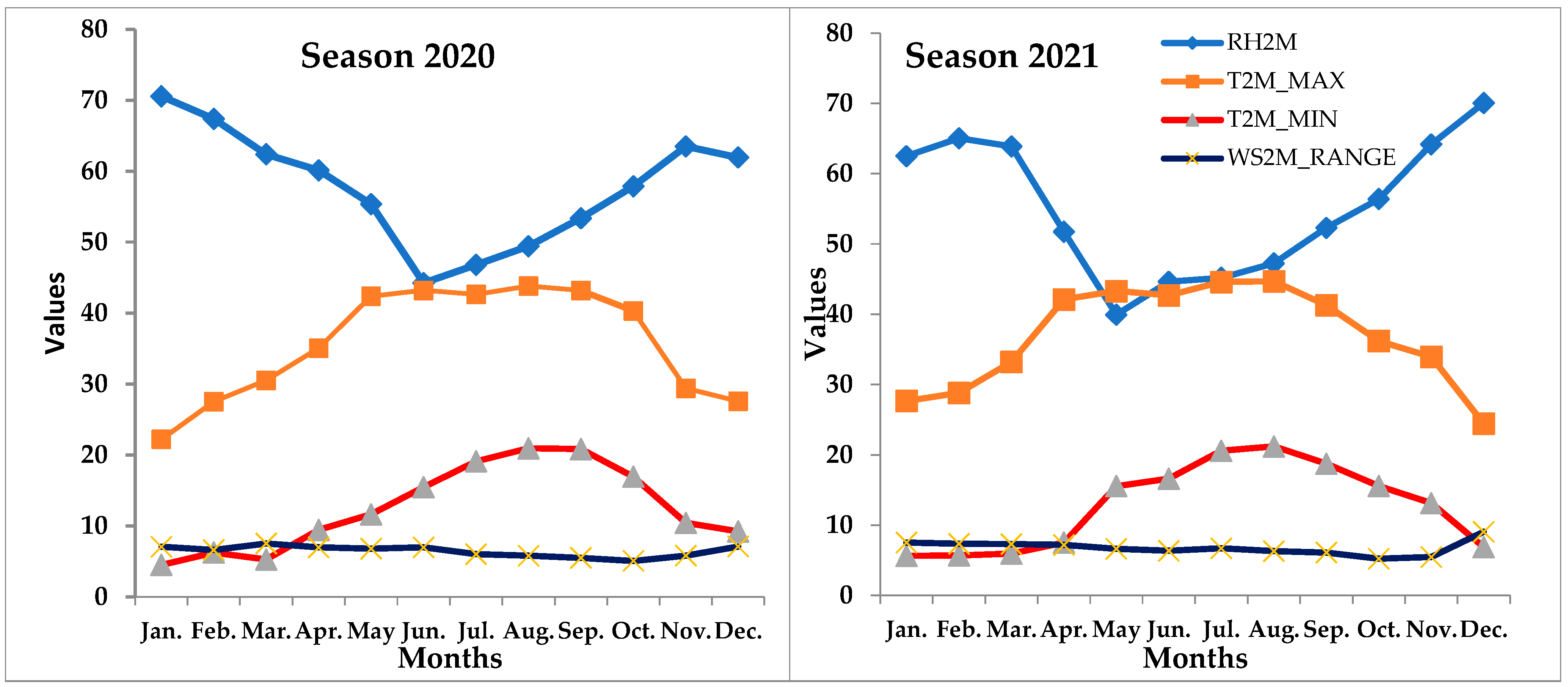
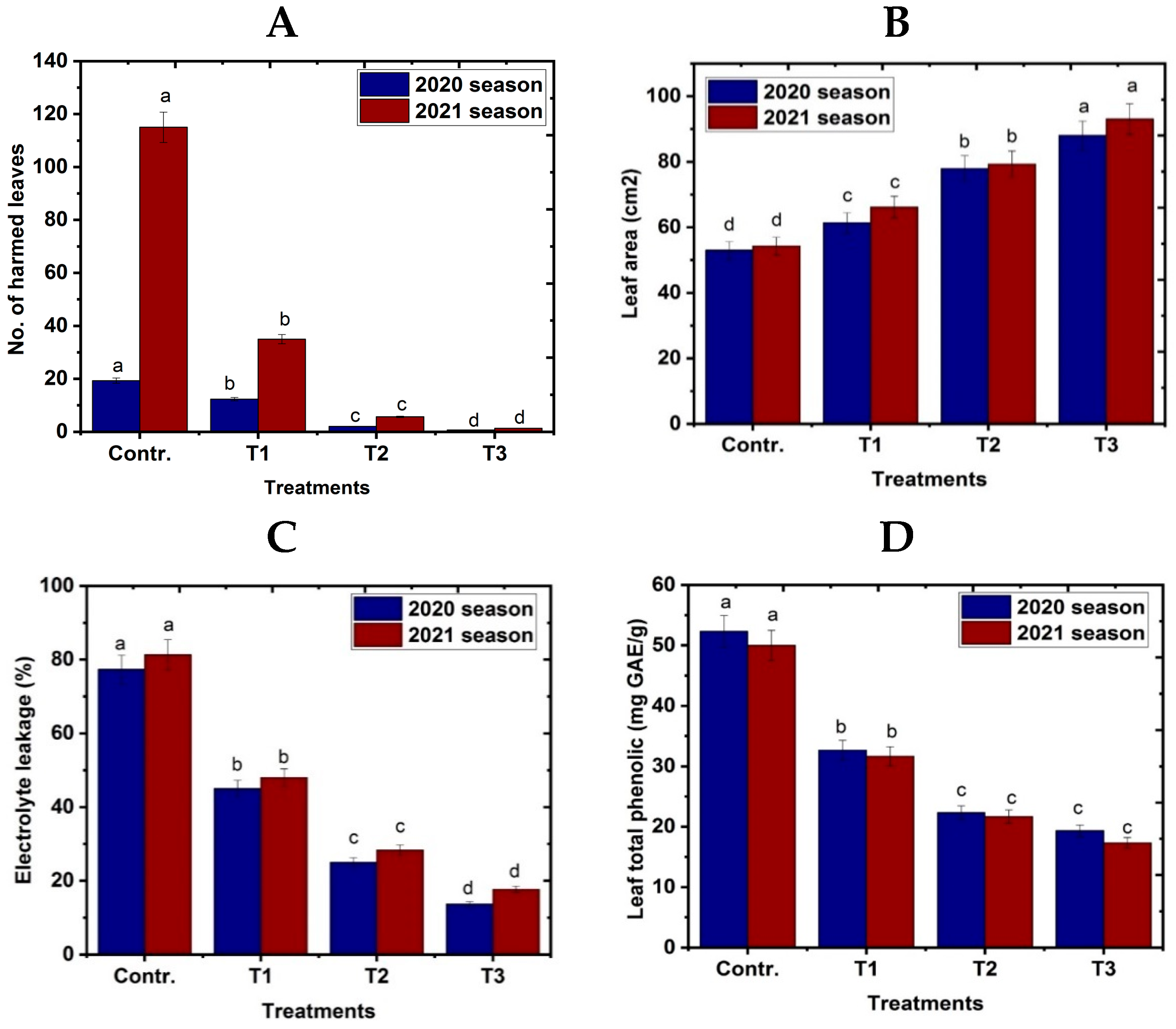

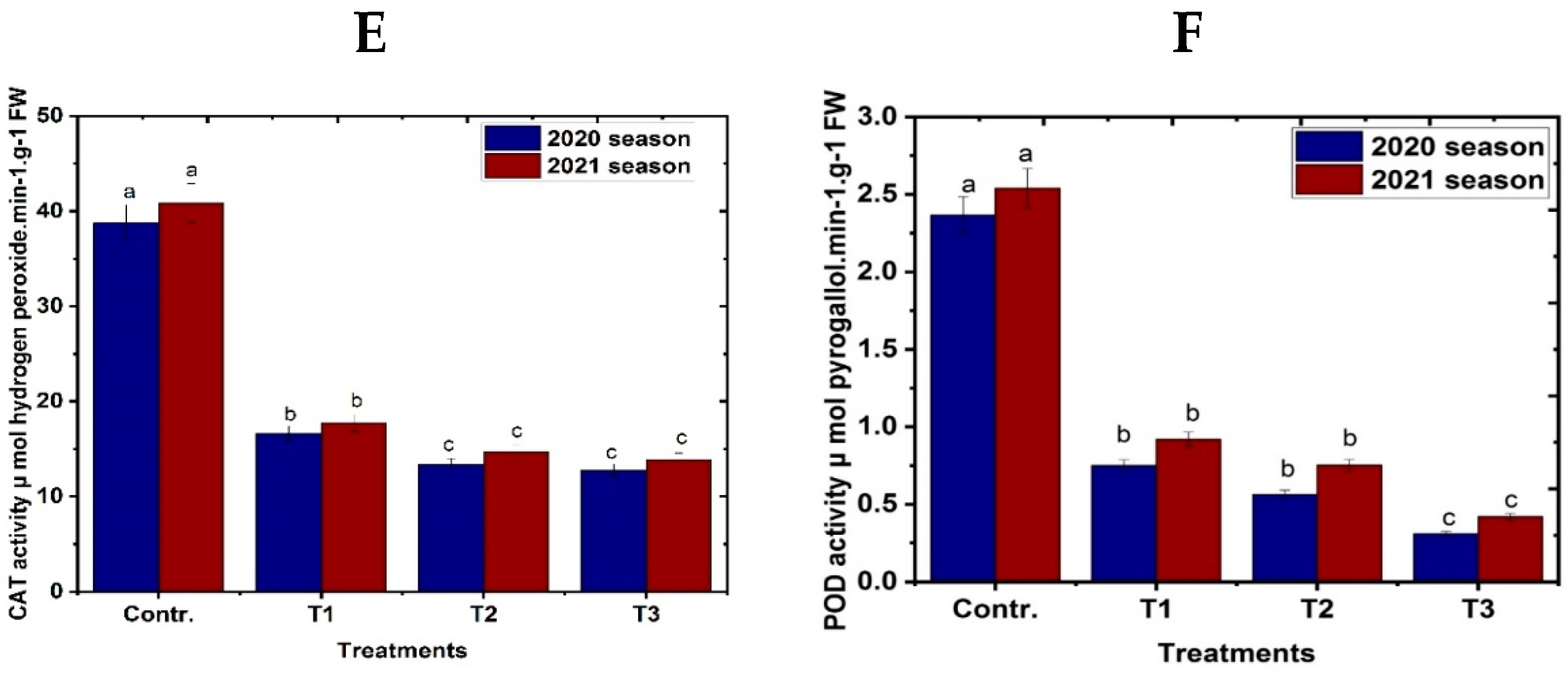
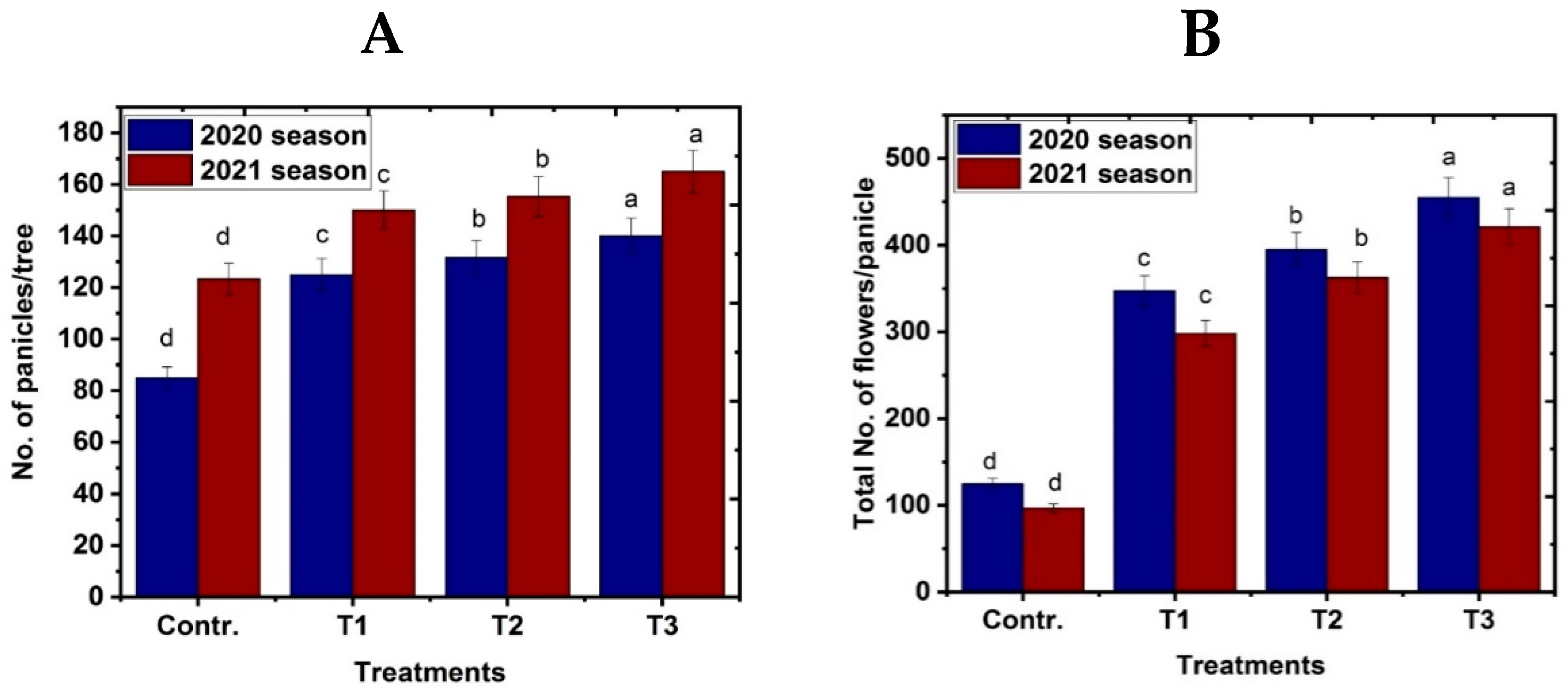
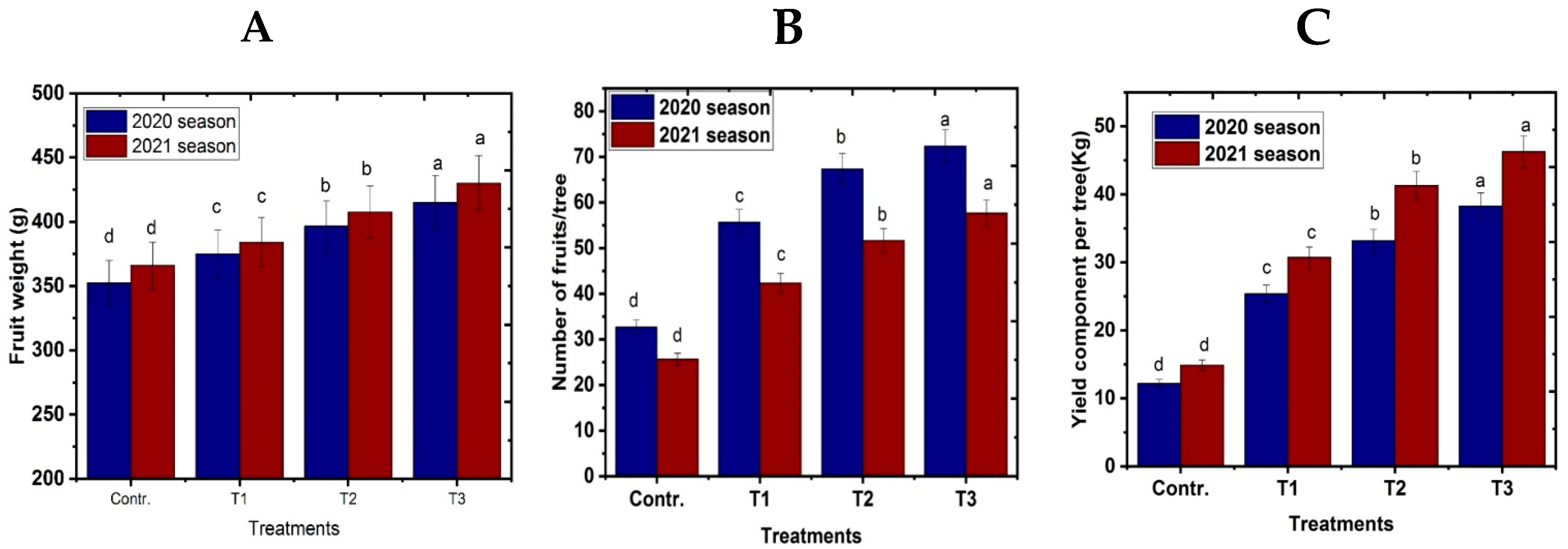


| Soil Physical Analysis | Soil Chemical Analysis | ||||||||||||
|---|---|---|---|---|---|---|---|---|---|---|---|---|---|
| Sand (%) | Silt (%) | Clay (%) | Soil Texture | EC (ds/m) | pH | Cations (meq/L) | Anions (meq/L) | ||||||
| Ca++ | Mg++ | Na+ | K+ | So4−− | CI− | HCo3− | Co3−− | ||||||
| 93.53 | 4.22 | 2.25 | Sand | 0.46 | 7.20 | 2.00 | 0.94 | 1.24 | 0.21 | 0.48 | 1.87 | 2.00 | 0.00 |
Disclaimer/Publisher’s Note: The statements, opinions and data contained in all publications are solely those of the individual author(s) and contributor(s) and not of MDPI and/or the editor(s). MDPI and/or the editor(s) disclaim responsibility for any injury to people or property resulting from any ideas, methods, instructions or products referred to in the content. |
© 2023 by the authors. Licensee MDPI, Basel, Switzerland. This article is an open access article distributed under the terms and conditions of the Creative Commons Attribution (CC BY) license (https://creativecommons.org/licenses/by/4.0/).
Share and Cite
Abdel-Aziz, H.F.; Hamdy, A.E.; Sharaf, A.; Abd El-wahed, A.E.-w.N.; Elnaggar, I.A.; Seleiman, M.F.; Omar, M.; Al-Saif, A.M.; Shahid, M.A.; Sharaf, M. Effects of Fogging System and Nitric Oxide on Growth and Yield of ‘Naomi’ Mango Trees Exposed to Frost Stress. Life 2023, 13, 1359. https://doi.org/10.3390/life13061359
Abdel-Aziz HF, Hamdy AE, Sharaf A, Abd El-wahed AE-wN, Elnaggar IA, Seleiman MF, Omar M, Al-Saif AM, Shahid MA, Sharaf M. Effects of Fogging System and Nitric Oxide on Growth and Yield of ‘Naomi’ Mango Trees Exposed to Frost Stress. Life. 2023; 13(6):1359. https://doi.org/10.3390/life13061359
Chicago/Turabian StyleAbdel-Aziz, Hosny F., Ashraf E. Hamdy, Ahmed Sharaf, Abd El-wahed N. Abd El-wahed, Ibrahim A. Elnaggar, Mahmoud F. Seleiman, Magdy Omar, Adel M. Al-Saif, Muhammad Adnan Shahid, and Mohamed Sharaf. 2023. "Effects of Fogging System and Nitric Oxide on Growth and Yield of ‘Naomi’ Mango Trees Exposed to Frost Stress" Life 13, no. 6: 1359. https://doi.org/10.3390/life13061359









